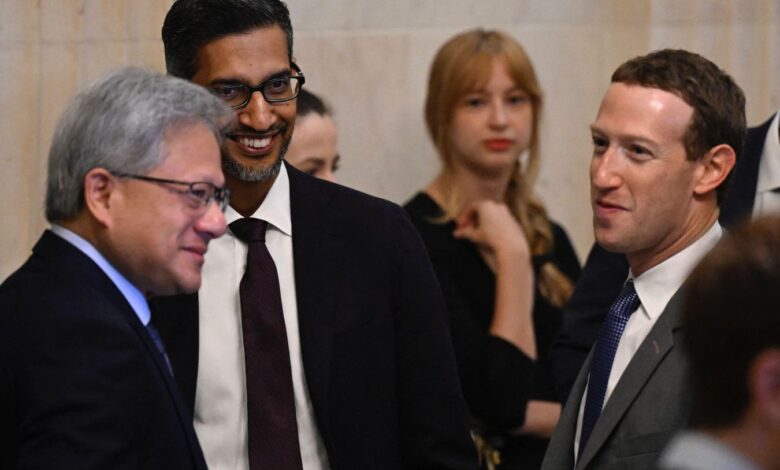Google TPUs Vs Nvidia GPUs

📝 usncan Note: Google TPUs Vs Nvidia GPUs
Disclaimer: This content has been prepared based on currently trending topics to increase your awareness.
(L to R) Jensen Huang, President and CEO of Nvidia Corporation, Google CEO Sundar Pichai, and Mark Zuckerberg (R), CEO of Meta, arrive for a US Senate bipartisan Artificial Intelligence (AI) Insight Forum at the US Capitol in Washington, DC, on September 13, 2023. (Photo by ANDREW CABALLERO-REYNOLDS / AFP) (Photo by ANDREW CABALLERO-REYNOLDS/AFP via Getty Images)
AFP via Getty Images
Google has begun placing its Tensor Processing Units (TPUs) in data centres run by smaller cloud providers that have long relied on Nvidia’s GPUs. This is more than a product rollout—it’s a calculated move in the AI infrastructure chess game.
The effects extend across the AI ecosystem, creating both opportunity and uncertainty for investors. While individual AI names like Google and Nvidia could see heightened volatility as the landscape shifts, those seeking exposure with less single-stock risk might prefer diversified approaches. The High Quality Portfolio, for example, has comfortably outperformed its blended benchmark—a mix of the S&P 500, Russell, and S&P MidCap indexes—and has delivered returns exceeding 91% since inception, letting investors participate in these structural shifts across multiple quality companies instead of betting on a single winner. Separately, see – How Oracle Stock Surges 3x To $900?
What Are TPUs?
TPUs are Google’s purpose-built AI chips designed specifically for machine-learning tasks. While Nvidia’s GPUs are versatile general-purpose processors, TPUs act like specialized scalpels optimized for AI workloads. The latest Ironwood chip delivers 42.5 exaflops of compute per pod with more than 9,200 chips per unit—“more than 10x improvement” over Google’s previous generation.
Why Is Google Opening the Vault?
- Revenue Diversification: Google’s cloud business needs every edge against Amazon’s AWS and Microsoft’s Azure. Licensing TPUs to smaller cloud providers opens new revenue streams while retaining technological control.
- Ecosystem Lock-in: Once developers optimize for TPUs, switching becomes costly and complex. Make your technology indispensable, then reap the benefits.
- Strategic Disruption: By seeding the market with TPU alternatives, Google can pressure Nvidia’s pricing power and reduce reliance on expensive Nvidia hardware.
Also, take a look at – How Does Google Stock Rise 2x?
What Does This Mean for Nvidia?
This puts Nvidia in an uncomfortable spot:
- Price Pressure: Competition pushes prices lower. If TPUs offer similar performance at better economics, Nvidia risks margin compression.
- Customer Diversification: Smaller cloud providers now have alternatives to Nvidia’s near-monopolistic grip on AI hardware.
Still, Nvidia enjoys a massive ecosystem and deep relationships. The key question: Can Google win meaningful share before Nvidia responds?
This is not just about chips—it’s about control of the AI infrastructure stack. Google is effectively telling the market, “You don’t need Nvidia’s ecosystem anymore.” Yet in reducing dependence on Nvidia, customers may increase dependence on Google’s technology.
For buyers, the trade-off is clear: would you rather be locked into Nvidia or Google?
Separately, look at – Are Nvidia Investors Ignoring This Big Risk?
What Happens Next?
- Nvidia’s Response: Expect aggressive pricing, fresh partnerships, or accelerated roadmaps. Nvidia won’t give up its share quietly.
- Customer Adoption: Technical performance matters, but so do ecosystem depth, developer tools, and migration costs.
- Amazon and Microsoft’s Countermoves: Don’t expect AWS (with its Inferentia chips) and Microsoft (with its partnership playbook) to sit idle. A broader custom-silicon arms race among hyperscalers could follow.
The Bottom Line
Google’s custom TPU push is a bid to challenge Nvidia’s dominance. But this isn’t a simple one-on-one duel. With companies like Broadcom, AMD, and Marvell advancing their own chips, AI hardware is now a multi-player race.
That’s good for the industry—more competition, more choice, and potentially lower costs. For investors, it signals a heating AI infrastructure market with no guaranteed single winner.
Nvidia isn’t finished, but the competition is tougher than ever.
While the AI arms race intensifies, you could explore the Trefis Reinforced Value (RV) Portfolio, which has outperformed its all-cap benchmark (a combination of the S&P 500, S&P MidCap, and Russell 2000) to deliver strong returns. Why? The quarterly rebalanced mix of large-, mid-, and small-cap RV Portfolio stocks provided a responsive way to benefit from upbeat markets while limiting losses when conditions turned, as shown in RV Portfolio performance metrics.




